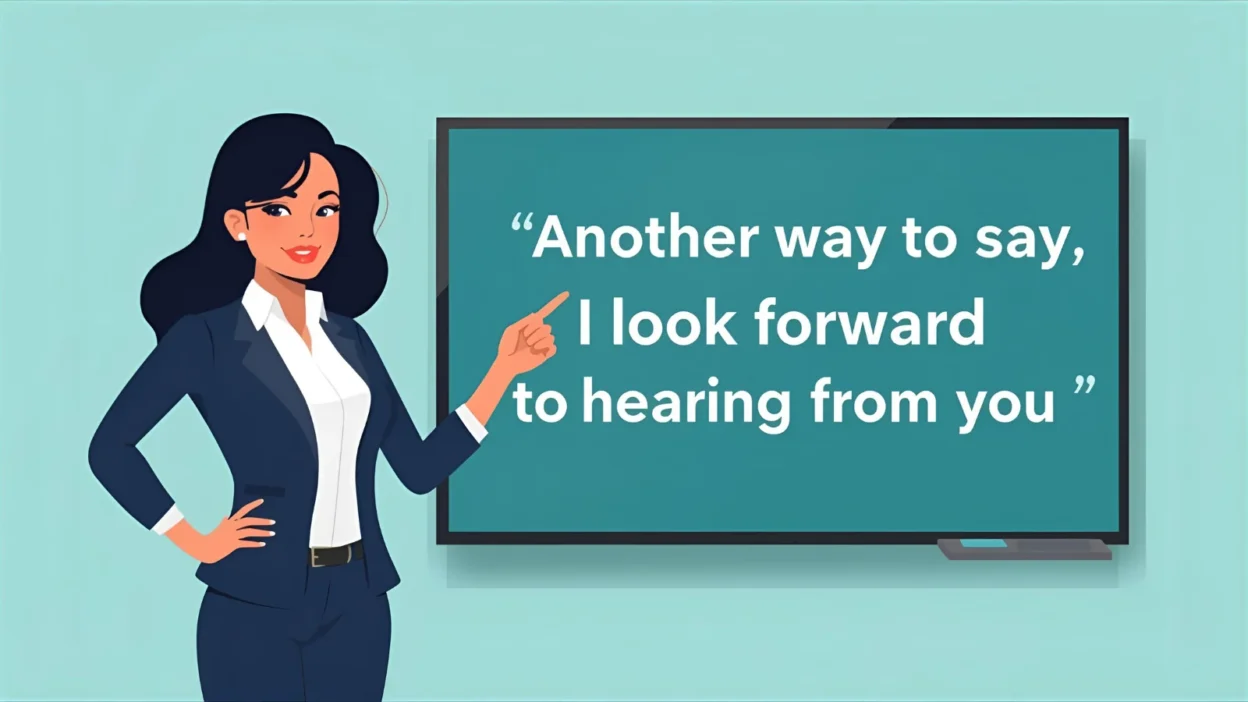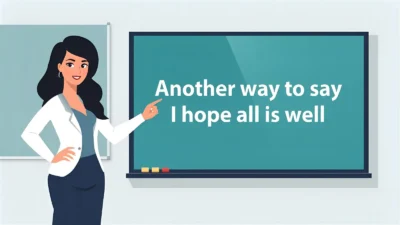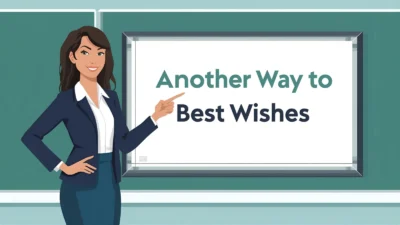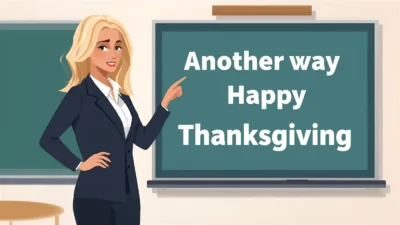The phrase “I look forward to hearing from you” is a classic and professional way to end an email or letter. It signals that you expect or hope for a reply, while maintaining a courteous and respectful tone.
However, using it repeatedly can sound formulaic or overly formal. Depending on your relationship with the recipient—be it a hiring manager, client, colleague, or friend—you might want to vary your closing to sound warmer, more confident, or more natural.
Below are 43 professional, polite, and friendly alternatives to “I look forward to hearing from you,” complete with meaning, detailed explanation, example, best use, and tone to help you communicate effectively in every context.
💼 Formal and Professional Alternatives
1. I look forward to your response
Meaning: A direct, professional way to express anticipation of a reply.
Detailed Explanation: Keeps the traditional tone but slightly more formal than the original phrase.
Example: I look forward to your response regarding the proposal.
Best Use: Business, corporate, or client emails.
Tone: Polite, professional, expectant.
2. I await your reply
Meaning: A more formal version expressing that you’re waiting for feedback.
Detailed Explanation: Shows attentiveness and professionalism, often used in written correspondence.
Example: I await your reply at your earliest convenience.
Best Use: Legal, academic, or business contexts.
Tone: Formal, respectful.
3. I await your response
Meaning: A polished, slightly old-fashioned but professional way to convey anticipation.
Detailed Explanation: More traditional, perfect for official letters or reports.
Example: I await your response on the updated terms.
Best Use: Formal business or government correspondence.
Tone: Formal, traditional.
4. I look forward to your feedback
Meaning: Invites a specific kind of reply—comments or input.
Detailed Explanation: Great for collaborative or review-based communication.
Example: I look forward to your feedback on the draft.
Best Use: Team, client, or supervisor correspondence.
Tone: Professional, cooperative.
5. I look forward to your thoughts
Meaning: Encourages open dialogue or opinion sharing.
Detailed Explanation: Works best when you value the recipient’s input.
Example: I look forward to your thoughts on the presentation.
Best Use: Internal communications, feedback requests.
Tone: Engaging, thoughtful, polite.
6. I appreciate your time and response
Meaning: Expresses gratitude and expectation together.
Detailed Explanation: Combines politeness with a professional tone.
Example: I appreciate your time and response on this matter.
Best Use: Client communication, job applications.
Tone: Grateful, formal, courteous.
7. I look forward to your reply at your earliest convenience
Meaning: Politely emphasizes a timely response.
Detailed Explanation: Common in formal settings requiring timely action.
Example: I look forward to your reply at your earliest convenience.
Best Use: Business or administrative follow-ups.
Tone: Respectful, formal.
8. Your response will be greatly appreciated
Meaning: Conveys politeness and gratitude for their forthcoming reply.
Detailed Explanation: Great for requests or inquiries that need acknowledgment.
Example: Your response will be greatly appreciated.
Best Use: Customer service, business requests.
Tone: Appreciative, formal.
9. I am eager to hear your feedback
Meaning: Conveys enthusiasm and interest.
Detailed Explanation: Adds positive energy to professional communication.
Example: I am eager to hear your feedback on the campaign proposal.
Best Use: Creative, team, or client collaborations.
Tone: Positive, proactive, warm.
10. I await your valuable feedback
Meaning: Highlights respect for the recipient’s expertise.
Detailed Explanation: Makes the person feel their input is valued.
Example: I await your valuable feedback on the document.
Best Use: Communications with mentors, managers, or clients.
Tone: Respectful, formal, appreciative.
💬 Polite and Neutral Alternatives
11. I hope to hear from you soon
Meaning: Expresses polite hope for a reply.
Detailed Explanation: Friendly but still professional; slightly softer tone.
Example: I hope to hear from you soon regarding the schedule.
Best Use: Customer service, networking, or general business emails.
Tone: Warm, professional, approachable.
12. Looking forward to your reply
Meaning: A simple, concise version of the original phrase.
Detailed Explanation: Commonly used in emails and less formal communication.
Example: Looking forward to your reply!
Best Use: General work correspondence.
Tone: Professional, neutral, friendly.
13. I hope for your prompt response
Meaning: Encourages timely communication without sounding demanding.
Detailed Explanation: Useful when time sensitivity matters.
Example: I hope for your prompt response regarding the contract.
Best Use: Time-sensitive matters, follow-ups.
Tone: Polite, professional, firm.
14. I’m looking forward to your input
Meaning: Invites contribution or ideas.
Detailed Explanation: Encourages collaboration and shows openness.
Example: I’m looking forward to your input on this proposal.
Best Use: Team or project-based communication.
Tone: Positive, engaging, inclusive.
15. I hope to hear back from you
Meaning: Friendly and polite closing expecting a response.
Detailed Explanation: A slightly more casual alternative for most contexts.
Example: I hope to hear back from you regarding the application.
Best Use: Networking, recruitment, informal business emails.
Tone: Polite, approachable.
16. I’m excited to hear your thoughts
Meaning: Adds enthusiasm and positivity.
Detailed Explanation: Ideal for creative or collaborative settings.
Example: I’m excited to hear your thoughts on the new design.
Best Use: Teamwork, creative projects, partnerships.
Tone: Enthusiastic, warm.
17. I’ll look out for your reply
Meaning: Indicates readiness to receive their response.
Detailed Explanation: Suggests attentiveness and expectation.
Example: I’ll look out for your reply once you’ve reviewed the draft.
Best Use: Informal yet professional communication.
Tone: Friendly, proactive, professional.
18. Please keep me posted
Meaning: Requests ongoing updates.
Detailed Explanation: Great for project tracking or progress check-ins.
Example: Please keep me posted on the results.
Best Use: Teamwork, collaborations.
Tone: Professional, conversational, friendly.
19. Please let me know your thoughts
Meaning: Encourages feedback or opinion sharing.
Detailed Explanation: More conversational, often used in friendly emails.
Example: Please let me know your thoughts when you have a moment.
Best Use: Internal communication, informal professionalism.
Tone: Polite, warm, collaborative.
20. I’ll wait for your update
Meaning: Simple and clear statement of expectation.
Detailed Explanation: Works well when awaiting project results or follow-ups.
Example: I’ll wait for your update once the analysis is complete.
Best Use: Ongoing business communication.
Tone: Neutral, professional.
🤝 Warm and Friendly Alternatives
21. Can’t wait to hear from you
Meaning: Expresses excitement and anticipation.
Detailed Explanation: Very friendly and informal.
Example: Can’t wait to hear from you soon!
Best Use: Personal or warm client relationships.
Tone: Friendly, enthusiastic.
22. Eager to connect soon
Meaning: Communicates excitement about future contact.
Detailed Explanation: Great for networking or new collaborations.
Example: Eager to connect soon and discuss next steps.
Best Use: Introductions, follow-up messages.
Tone: Energetic, polite.
23. Excited to hear your feedback
Meaning: Expresses anticipation and positivity.
Detailed Explanation: Perfect for team or creative work exchanges.
Example: Excited to hear your feedback on the concept.
Best Use: Creative industries, teamwork.
Tone: Positive, approachable.
24. Talk soon
Meaning: A casual, friendly sign-off implying continued communication.
Detailed Explanation: Perfect for informal or familiar relationships.
Example: Talk soon,
Maya
Best Use: Colleague, friend, or long-term client emails.
Tone: Warm, informal, friendly.
25. Looking forward to catching up
Meaning: Suggests a personal or ongoing relationship.
Detailed Explanation: Best when you already have a rapport with the person.
Example: Looking forward to catching up next week!
Best Use: Networking or friendly professional exchanges.
Tone: Personal, friendly, light.
Conclusion
While “I look forward to hearing from you” is perfectly polite and professional, using different alternatives allows you to fine-tune your tone—whether you’re writing a formal proposal, a job application, or a friendly check-in.
- For formal situations, use “I await your response” or “Your response will be greatly appreciated.”
- For neutral and professional communication, try “I look forward to your feedback” or “I hope to hear from you soon.”
- For friendly and warm tones, opt for “Can’t wait to hear from you” or “Talk soon.”
A well-chosen closing line leaves a lasting impression—showing confidence, respect, and warmth in every message. 💬✨



